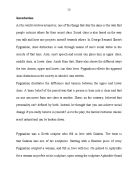In the transforming Victorian society, female independence is not yet achieved. Higgins’s arrogant attitude towards woman reveals the traditional gender stereotype by the society. “The girl doesn’t belong to anybody-is no use to anybody but me,” he says. Higgins, in saying Eliza doesn’t “belong” to anyone, implies that a young woman should “belong” to someone. This is further emphasized as Higgins says to Eliza after she is well transformed into a elegant, eloquent and eligible young woman, “You might marry, you know”. This shows that the majority in Victorian society believe a woman’s destiny is to get married. In addition, women who are in higher class do not value themselves, and believe that only men have places in the society. Clara goes to meet Higgins with “confident familiarity”, and respond “gainly” after Higgins speaks rudely to her. This expression of Clara shows that women in higher class do not have freedoms and choices, the only way to keep places in society is to get connected with men. This also can be proved by Eliza, as she turns into a lady in the end, she realizes that her life isn’t turn out to be better. “Now you have made a lady of me, I’m not fit to sell anything else. I wish you’d left me where you found me”. This indicates that higher-class woman have no place in the society as they cannot afford their own costs. Lastly, Shaw shows that women cannot be successful by themselves in the early 20th century England. Eliza eventually turns out to be a duchess at ambassador's party, and is well welcomed by them. However, Higgins mentions that “he’ll have to pay for all those togs you have been wearing today; and that, with the hire of the jewelry, will make a big hole in two hundred pounds.” Without Pickering’s financial support, Eliza will never able to be success in turning to be a duchess at the party. This idea can also be enhanced as Eliza says “I will go and be a teacher” when she decides to leave Higgins. She is using the language that Higgins taught her to afford her own cost; she cannot to be successful when speaking her own language.
To conclude, Bernard Shaw shows a British society in transition, where he hopes equality can be achieved. However, in the Victorian era, progressive notions of femininity crashes with established gender stereotype as Eliza in the end perceives that women in the upper class do not have the independence that woman in the lower class do; they must be connected to a man in some way to be respectable within “middle-class morality”.







